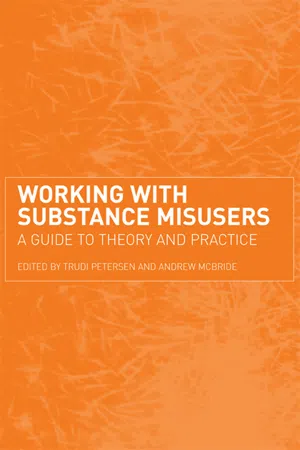
Working with Substance Misusers
A Guide to Theory and Practice
Trudi Petersen, Trudi Petersen
- 392 Seiten
- English
- ePUB (handyfreundlich)
- Über iOS und Android verfügbar
Working with Substance Misusers
A Guide to Theory and Practice
Trudi Petersen, Trudi Petersen
Über dieses Buch
Working with Substance Misusers is a practical handbook for students and those who work with people who misuse drugs or alcohol. Written by experienced teachers and clinicians, the book introduces:
* the substances themselves
* theories relevant to substance use and misuse
* the skills necessary to work with this client group
* the broad range of approaches to treatment
* particular problems of specific groups.The reader is encouraged to read and reflect on the material in relation to their own practice. To help this process, each topic has an identified set of learning objectives. Activities designed to reinforce learning include discussion points, case studies, role plays and group exercises. Working with Substance Misusers makes clear the connection of theory to practice and encourages a skills-based, but reflective, approach to work in this complex field. Cutting across professional boundaries, it provides both new and more experienced practitioners with a key text.
Häufig gestellte Fragen
Information
Part I The Basics
Chapter 1 Some Drugs of Misuse
Introduction
A Simple Classification Of Psychoactive Drugs
- Stimulants; that wake you up, speed you up and give you energy. This group includes amphetamine and cocaine.
- Depressants; that make you calm, drowsy or put you to sleep. This group includes opioids, benzodiazepines, volatile substances and cannabis.
- Hallucinogens; that change your perception of the world, by distorting what you see and hear, or make you experience things that aren't there at all. This group includes LSD and Magic Mushrooms.
- Others; this group might include drugs with relatively little potential for misuse such as antipsychotic and antidepressant drugs.
Drug Effects
- the amount taken (the dose)
- the number and timing of doses
- the route by which the drug is taken
- by mouth
- by smoking
- by injection (subcutaneous, intramuscular, intravenous)
- the speed with which the drug reaches the brain
- the rate at which the drug is broken down (or excreted unchanged)
- the user's past experience with this and similar drugs
- expectations
- motivations
- physiological tolerance to the drug's effects
- whether the drug is taken alone or in combination with other drugs
- the circumstances in which the drug is taken
- place
- atmosphere
- company
- The person
- inherited biology
- personality
- health
- mood
The same dose of the same drug can have different outcomes
- A sixth-form school student, who has never drunk alcohol before, at a post-exam celebration night out, who drinks lager over 3 hours.
- A middle-aged, middle-class woman at her weekly bridge club, who drinks gin and tonic over a period of 5 hours.
- An alcohol dependent serial killer who has been taking amphetamine and high doses of benzodiazepines for two weeks, who injects vodka intravenously in the bathroom of a house he is burgling whilst the residents are asleep.
- A bishop alone, at home, grieving over the death of his wife, who drinks sherry over 2 hours before going to bed, because he hasn't slept for two nights.
Drug effects and drug interactions
Drug prices
- When pharmaceutical amphetamines effectively disappeared because of controls on prescribing, it was replaced by amphetamine sulphate ‘powder’ from illegal laboratories. A gram of good quality (probably 70+ per cent) amphetamine cost around £10 in South Wales in the early 1970s, but would fuel two nights out for a couple of people. Twenty years later the price was the same, but the purity had fallen to between 0 (yes, zero) and 10 per cent. The fall in purity more than made up for price inflation. Increased availability and competition from heroin has since pushed the purity up and the price down.
- In 1991 heroin was effectively unavailable in South Wales. When it was first brought over the Severn Bridge from Bristol it was sold in £10 wraps which contained maybe one fifteenth of a gram of poor quality stuff. By 2001 heroin was widely av...
Inhaltsverzeichnis
- Cover Page
- Half Title Page
- Title Page
- Copyright Page
- Dedication
- Table of Contents
- Figures and Tables
- Contributors
- Acknowledgements
- Introduction
- PART I The basics 1 Some drugs of misuse
- PART II The care and treatment of substance misusers
- PART III Organisational and policy issues
- PART IV Some specific populations
- PART V Case studies